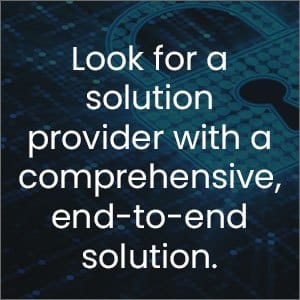These days, what’s most critical to companies is knowing the terms of business relationships with investors, employees, customers, suppliers, and partners. So is ensuring agreements are only accessible to those who have rights and privileges.
Well, secure contract management is a means to those ends. And it all starts with technology, like firewalls, intrusion prevention systems, and encryption.
But it certainly doesn’t end there. What’s also crucial is implementing strategies and practices for secure contract management, and making sure they continue to be effective. After all, it’s better to discover vulnerabilities in your own people, processes, and technology than allow hackers, customers, or other external parties to identify them. In doing so, you can remediate any issues without damaging your reputation, losing your data, or ending your business relationships altogether.
In 2020, contract-related data privacy was a top-three trend, according to CIOReview.com. That promises to continue this year – and beyond.
With this in mind, here are five essentials tips to protect your own contracts and safeguard your business.
1. Choose the Right Secure Contract Management Software Vendor
There are many technology companies on the market that offer secure contract management software and services. Yet, it’s important to know all of the attributes of providers to see if they’re worthy of your business. In addition to confirming the security of the software, a company should:
- Look for a vendor that offers a comprehensive, end-to-end solution as opposed to a point product. (An integrated solution addresses only one piece of the contract lifecycle management (CLM) picture, like contract assembly or reviews. Multiple integration points, on the other hand, can lead to points of vulnerability that hackers can exploit.)
- Seek out a service provider that has partner relationships with technology infrastructure and application companies you know and trust, such as Microsoft Azure. (The CLM solution can then inherit industry certifications like HIPAA, PCI, or SOC III from the cloud platform vendor)
- Make certain the vendor you entrust your contract management to has a good deal of expertise in contracts and technology
- Look for a company that has testimonials, success stories, and third-party certifications that instill confidence. (You should know that you are dealing with a reputable provider you can trust)
- Prioritize companies that are completely focused on contract lifecycle management. (If contract management is just a line item on a service provider’s product portfolio, the product could be dropped from their portfolio or may not receive much-needed R&D attention)
Finally, it’s a good sign if the vendor has earned the recognition of industry associations like World Commerce and Contracting (World CC). (Short-term data security is one thing. But long-term vendor stability and viability ensure the availability and reliability of your CLM investment for years to come.)
2. Choose a CLM Solution That is Flexible and Fits in your App Ecosystem
Cloud-based application security has come a long way in recent years. However, your company may only prefer on-premises hosting in the beginning. In fact, a CLM solution that can be deployed in your private-cloud data center immediately – and migrated to the public cloud (or not) in the future – may be more ideal for your organization (You should have the full flexibility to choose!)
Next, integrating your CLM solution with your ERP and/or CRM platforms – with proven API connectors – is a great way to create efficiencies. It also mitigates the vulnerabilities associated with third-party plugins. Vendor consultants can leverage their application expertise to build bespoke integrations and workflows, not to mention securely embed CLM systems into app ecosystems.
3. Restrict Permissions with Principle of Lease Privilege
Most cybersecurity events are the result of internal employees’ actions. So, limiting access to contracts decreases the possibility of a breach or confidentiality leak, and protects your company’s interests overall.
Still, access control goes beyond the ability to open a contract. Many businesses use CLM platforms to limit who can find a contract in a search, who can edit a contract in the repository, and even who can print or email contract documents. Whether you’re negotiating a contract or nearing renewal time, it’s important to prevent sensitive contract information from falling into the wrong hands. That can impede your ability to negotiate future contracts, or unwittingly expose your sensitive information or that of other contract parties.
4. Paper Contracts are Inevitable, But Persuade Skeptics With Electronic Signatures
Let’s face it, it’s difficult to imagine why some organizations would want to conduct business with paper agreements in 2021. Yet, many government organizations and regulated industries maintain rooms full of filing cabinets and industrial racks full of bankers boxes. And each is filled with contracts, invoices, and other business correspondence.
Instead, they would do well to implement a CLM solution that helps users find physical and electronic contracts through a unified search. Some information workers might require access to a physical contract’s metadata, like creation or expiry dates. Others may need to know where a paper contract is located – perhaps in a drawer or on a shelf. Or they may simply need to view a digital copy of an agreement.
Working with contracts that are signed digitally with wet ink is a more productive way to do business, too. The adoption of e-signatures and watermarks helps maintain business momentum during a period of crisis and ensures contracts are authentic. This is particularly true for any business that now conducts business away from the office or remotely.
Digital signatures also capture who signs an agreement, along with when and where the document is signed. So, they’re in many ways more secure than ink signatures, which are easier to forge. Adopting a CLM solution – compatible with an e-signature application like DocuSign – is a perfect way to comply with industry regulations while securing contract management.
5. Encrypt At-rest and In-transit Contracts
When it comes to at-rest contracts – whether on servers or in the cloud – many IT, legal, and contract management professionals are highly focused on firewalls, data loss prevention systems, and other security layers. Sometimes, they take for granted that their agreements are encrypted and secure, as they pass contracts back and forth through emails or even text messages.
A secure online utility like ContractPodAi’s “Express Contract Collaborator” enables all parties to a contract negotiation to access the agreement, make tracked revisions from the device of their choice, and ensure that every contract version is maintained. Without it, email threads between multiple contract parties can end up with overwritten changes. Or if key stakeholders cannot get to their email, the negotiation process could slow to a halt.
At the end of the day, secure contract management requires the commitment of the entire organization. After all, your company’s reputation and profitability depend on your ability to comply with industry regulations. And they depend on your contracts being completely available, authentic, and secure. So, companies need to establish and follow strict policies around business agreements, as a result. They also need to choose a CLM platform that facilitates secure, real-time negotiation.
Download our latest whitepaper, ‘How to Choose a Contract Management Solution,’ which helps legal teams define their own CLM needs. Also, contact ContractPodAi for a demo of our unique CLM solution today. And see how you can adopt and implement one for your legal team, too.




